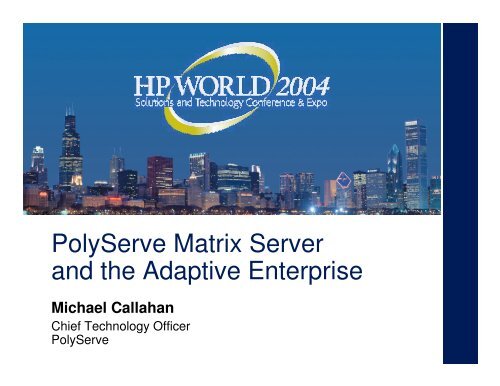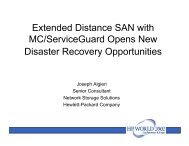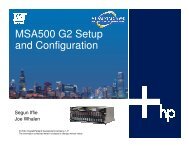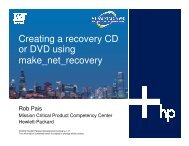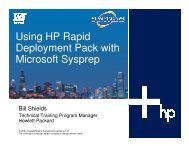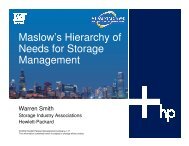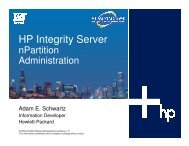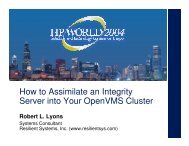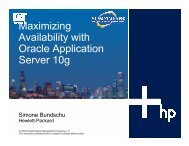PolyServe Matrix Server and HP Blade Clusters - OpenMPE
PolyServe Matrix Server and HP Blade Clusters - OpenMPE
PolyServe Matrix Server and HP Blade Clusters - OpenMPE
Create successful ePaper yourself
Turn your PDF publications into a flip-book with our unique Google optimized e-Paper software.
<strong>PolyServe</strong> <strong>Matrix</strong> <strong>Server</strong><br />
<strong>and</strong> the Adaptive Enterprise<br />
Michael Callahan<br />
Chief Technology Officer<br />
<strong>PolyServe</strong>
Shared Data Clustering with <strong>Matrix</strong> <strong>Server</strong><br />
• Software for Shared Data Clustering<br />
− Think TruCluster/VAXCluster-like<br />
clustering for Intel (shared SAN files)<br />
− Works with <strong>HP</strong> ISS servers;<br />
<strong>HP</strong> MSA/EVA/XP storage<br />
− RHAS 2.1/3.0; SUSE SLES 8;<br />
Windows 2000 <strong>and</strong> 2003<br />
• Cluster File System<br />
− All servers access common apps, data<br />
on SAN at full speed (no bottleneck)<br />
• Integrated high-availability<br />
− Monitoring of hardware, software health<br />
− Configurable failover policies<br />
• Single point of administration<br />
− Central console for unified admin<br />
− Multi-server view<br />
Database<br />
(Oracle, SQL)<br />
Application<br />
<strong>Server</strong><br />
<strong>PolyServe</strong> <strong>Matrix</strong> <strong>Server</strong><br />
Shared-Data Clustering Software<br />
Linux or Windows<br />
Web<br />
<strong>Server</strong><br />
Software Hardware<br />
2
Customer Success<br />
• Over 300 customers across a wide set of industries, including<br />
media, telecom, financial services, retail <strong>and</strong> the government<br />
3
<strong>Matrix</strong> <strong>Server</strong> Solutions<br />
•<strong>Matrix</strong> <strong>Server</strong> for Linux<br />
− Focus: Unix-to-Linux<br />
migration<br />
• Scalability: scale-out DB &<br />
file-based apps<br />
• Manageability: shared app<br />
install, common data pool<br />
• Availability: failover<br />
•Solution areas<br />
− Oracle9i & 10g RAC<br />
− Database consolidation<br />
− Scalable NAS <strong>Clusters</strong><br />
− Custom applications<br />
•<strong>Matrix</strong> <strong>Server</strong> for Windows<br />
− Focus: consolidation for<br />
manageability & HA<br />
• Manageability: reduce OS<br />
instance count (“Blaster effect”<br />
burden)<br />
• HA: provide failover for all apps<br />
in cluster<br />
•Solution areas<br />
− SQL <strong>Server</strong> consolidation<br />
− Oracle9i & 10g RAC<br />
− Oracle non-RAC consolidation<br />
− Scalable CIFS file serving /<br />
file server consolidation<br />
− Custom applications<br />
4
Manageable Oracle9i & 10g RAC<br />
The Only Proven Cluster File System for RAC<br />
• Improved Oracle Manageability<br />
−Shared Oracle home (install/patch<br />
once)<br />
−Support for ASM<br />
−Eliminates the use of raw partitions<br />
−Rolling upgrade capability<br />
−Support for st<strong>and</strong>ard backup tools<br />
• Improved Scalability <strong>and</strong> Performance<br />
−Bigger clusters than competing<br />
products<br />
−ODM for high performance async I/O<br />
−Parallel ETL improves data loading<br />
performance<br />
• Improved High Availability<br />
−No single point of failure with Multi-<br />
Path I/O<br />
5
High Performance NAS <strong>Clusters</strong><br />
• 6:1 Price Performance Advantage over<br />
NAS<br />
−<br />
−<br />
−<br />
5x I/O throughput compared to NAS<br />
Scale system throughput on<br />
dem<strong>and</strong><br />
Leverage economics of industry<br />
st<strong>and</strong>ard building blocks<br />
• Fault Tolerance<br />
−<br />
−<br />
Better Performance at 25% the Cost of NAS<br />
Seamless failover for both NFS <strong>and</strong><br />
CIFS<br />
No single point of failure with Multi-<br />
Path I/O<br />
• Manage <strong>Server</strong>s <strong>and</strong> Storage as One<br />
−<br />
−<br />
−<br />
−<br />
A single global file system<br />
namespace<br />
A single pool of storage<br />
Central console for cluster <strong>and</strong><br />
storage management<br />
Central backup at SAN speeds<br />
6
Database Consolidation<br />
• Lower Costs<br />
− Eliminates active-passive pairs<br />
− Increase server <strong>and</strong> storage utilization<br />
• Operational Flexibility<br />
− Move databases to any server in cluster<br />
- rebalancing of load without data<br />
migration<br />
• Fault Tolerance<br />
− Every server becomes a backup<br />
− No single point of failure with Multi-<br />
Path I/O<br />
− Very fast failover with no SCSI takeover<br />
• Simplified Cluster Management<br />
− Install/patch/configure once clusterwide<br />
− Central console for cluster<br />
management<br />
− Central backup at SAN speeds<br />
Support for Oracle 8, 8i, 9i, 10g, Sybase ASE, <strong>and</strong> IBM DB2<br />
7
SQL <strong>Server</strong> Consolidation<br />
Save 50% on Clustered SQL <strong>Server</strong> Deployments<br />
• Simplified Manageability<br />
• One management console<br />
• Consistent drive letters cluster-wide<br />
• Back-up one central repository<br />
• Easy High Availability<br />
• Many-to-many fail-over<br />
• All applications can “afford” high availability<br />
• Less downtime with roll-through upgrades<br />
• Operational Flexibility<br />
• Rebalance application/database-to-server<br />
associations with no data moves<br />
• Add capacity on-the-fly with no downtime<br />
• Shift applications by failing-up to a bigger box<br />
8
Windows File <strong>Server</strong> Consolidation<br />
Six Times Better Price/Performance than NAS<br />
•Industry-Leading Price/Performance<br />
−5X I/O throughput compared to NAS<br />
−Scale system throughput on dem<strong>and</strong><br />
•Simplified Management<br />
−A single global file system namespace<br />
−A single pool of storage<br />
−Central console for cluster <strong>and</strong> storage<br />
management<br />
−Central backup at SAN speeds<br />
•Low-Cost High Availability<br />
−Eliminate downtime with many-to-many<br />
failover<br />
−Seamless failover for CIFS<br />
9
High Performance Data Sharing &<br />
Consolidation<br />
• Improved Storage Management<br />
−Manage single pool of storage<br />
−Increased storage utilization to<br />
75+%<br />
−Simplified central backup<br />
• Performance <strong>and</strong> Scalability<br />
−Multiple servers access same<br />
data at SAN speed<br />
−Parallel process data with full<br />
data integrity<br />
−Better performance for sharing<br />
data than FTP, NFS, or CIFS<br />
• High Availability<br />
−No single point of failure with<br />
Multi-Path I/O<br />
−Move applications from server to<br />
server<br />
10
Simplified Web Content Consolidation<br />
Triple Storage Utilization for Web <strong>Server</strong>s<br />
•Simplified Management<br />
−All servers share same Web content<br />
−Eliminate file replication <strong>and</strong> storage waste<br />
−Single pool of storage to manage<br />
−Simplified backup of centralized repository<br />
•Low-Cost High Availability<br />
−Log files highly available on shared SAN –<br />
even during server outages<br />
−Consolidate log files for easy postprocessing<br />
or compliance audits<br />
•Simplified Publishing<br />
−“Point-To” content publishing – no copying<br />
−All servers guaranteed to serve current<br />
content<br />
Many copies of content<br />
One location of shared data<br />
11
<strong>HP</strong>/<strong>PolyServe</strong> Success Story:<br />
Major Retail Bank<br />
•Example of High Performance<br />
Data Sharing & Consolidation<br />
Solution<br />
•Deployment Goals<br />
− Move financial transaction<br />
logging app from Sun to Linux<br />
− Achieve “stateless computing”<br />
model<br />
•Results<br />
− Custom Java app consolidates<br />
transaction log in shared file<br />
system<br />
− Achieved zero downtime with<br />
~30M transactions/day<br />
− Deployed at three production<br />
sites<br />
• SOLUTION<br />
• 24 <strong>HP</strong> ProLiant BL20 blades<br />
(growth to 96 blades per<br />
site)<br />
• <strong>PolyServe</strong> <strong>Matrix</strong> <strong>Server</strong><br />
• SuSE Linux Enterprise<br />
<strong>Server</strong><br />
• Custom Middleware<br />
Application<br />
• McData Director-Class SAN<br />
Fabric<br />
• 3 <strong>HP</strong> EVA 3000 Storage<br />
Arrays<br />
12
Enabling the Adaptive Enterprise<br />
• Tactical step towards utility<br />
computing<br />
− “Rip & Replace” industryst<strong>and</strong>ard<br />
blades<br />
− Move to stateless computing<br />
• Robust platform for missioncritical<br />
computing<br />
− All active<br />
− Pervasive high-availability<br />
• Scale-out for IT Consolidation<br />
− Single point of management for<br />
server <strong>and</strong> storage resources<br />
• Companies can do this today<br />
13
<strong>HP</strong>/<strong>PolyServe</strong> Success Story: Open<br />
Solutions<br />
• SOLUTION<br />
• 2 clusters of 3 nodes each<br />
• Example of Oracle9i RAC<br />
Manageability solution<br />
• Deployment Goals<br />
− Deliver hosted financial processing<br />
<strong>and</strong> transaction services to 13 major<br />
financial institutions clients (at<br />
present)<br />
− Deliver 24x7 uptime<br />
− Improve performance to support<br />
increasing dem<strong>and</strong> <strong>and</strong> clients<br />
• Results<br />
− <strong>PolyServe</strong> solution cost 20% the<br />
hardware <strong>and</strong> maintenance of UNIX<br />
alternatives<br />
− No downtime since production<br />
• <strong>PolyServe</strong> <strong>Matrix</strong> <strong>Server</strong><br />
• Oracle9i RAC<br />
• 2 <strong>HP</strong> BL20 blade server<br />
chassis<br />
• <strong>HP</strong> EVA 5000 SAN array<br />
with 4 TB storage<br />
14
<strong>HP</strong>/<strong>PolyServe</strong> Success Story:<br />
Datavantage<br />
• Example of Oracle9i RAC Manageability<br />
Solution<br />
• Deployment Goals<br />
− Migrate transaction based application from<br />
UNIX to Linux infrastructure.<br />
− Deliver 24x7 high availability<br />
− Support on dem<strong>and</strong> scalability due projected<br />
transaction volume increase of 150-200% yearover-year<br />
• Results<br />
− Saved over $750,000 compared to UNIX<br />
solution<br />
− Increased performance by 300%<br />
− Delivered 24x7 availability<br />
− Implemented site to site disaster recovery<br />
•QUOTES<br />
•“The drastically reduced server costs<br />
<strong>and</strong> easy management of the <strong>PolyServe</strong><br />
<strong>Matrix</strong> <strong>Server</strong> solution, alone, could have<br />
justified this deployment. But knowing we<br />
have a highly available, scalable platform<br />
<strong>and</strong> increased performance threefold — that<br />
sealed the deal.”<br />
• - Thomas J. Colarik<br />
• Vice President, Integrated Retail Solutions<br />
•“I feel like we got something for nothing.<br />
With <strong>PolyServe</strong> <strong>Matrix</strong> <strong>Server</strong>, we were<br />
able to triple our performance, reduce our<br />
costs by three-fourths, while greatly<br />
improving high availability <strong>and</strong> system<br />
management. That doesn’t happen very<br />
often in IT!”<br />
• - Ian Amit<br />
• Stored Value Project Manager<br />
15
<strong>HP</strong>/<strong>PolyServe</strong> Success Story: Classified<br />
Ventures<br />
Joint Venture of Belo Corp., Gannett ,<br />
Knight Ridder, The McClatchy<br />
Company, Tribune Company & The<br />
Washington Post Company<br />
• Example of Oracle9i RAC Manageability<br />
solution<br />
• Deployment Goals<br />
− Deploy a robust platform, able to support<br />
mission-critical service levels, including e-<br />
commerce<br />
− Deliver a pay as you grow architecture that can<br />
support doubling of traffic every year<br />
− Migrate from a UNIX platform to Linux clusters<br />
− Simplify database administration <strong>and</strong><br />
management<br />
• SOLUTION<br />
• 2 clusters of 4-way <strong>HP</strong><br />
Proliant DL580 <strong>Server</strong>s (1<br />
3-node cluster <strong>and</strong> 1 2-<br />
node cluster)<br />
• Oracle9i RAC<br />
• <strong>PolyServe</strong> <strong>Matrix</strong> <strong>Server</strong><br />
• Red Hat Enterprise Linux<br />
• Fibre Channel SAN<br />
• Support mission-critical service levels<br />
− Saved $1.75M in capital <strong>and</strong> support costs<br />
over a three-year period<br />
− Deployed robust <strong>and</strong> stable environment to<br />
support increased functionality <strong>and</strong> SLAs<br />
− Achieved highly available <strong>and</strong> scalable system<br />
16
Summary<br />
• <strong>PolyServe</strong> <strong>Matrix</strong> <strong>Server</strong> enables UNIX replacement <strong>and</strong> infrastructure<br />
consolidation projects<br />
• <strong>PolyServe</strong> & <strong>HP</strong> deliver a compelling, differentiated solution that meets<br />
the needs of CIOs seeking to cut costs <strong>and</strong> deliver high levels of<br />
service<br />
17
<strong>PolyServe</strong> <strong>and</strong> <strong>HP</strong><br />
• Resale Agreement<br />
− <strong>HP</strong> resells all <strong>PolyServe</strong> software products <strong>and</strong><br />
services<br />
• Bilateral Support Agreement with <strong>HP</strong> Services<br />
− Integrated call management for <strong>PolyServe</strong> products on<br />
<strong>HP</strong> systems<br />
• Joint Solution Development<br />
− IT Consolidation<br />
− Oracle<br />
− Scalable NAS <strong>Clusters</strong><br />
18
Appendix
Better than the Status Quo: Shared<br />
Data<br />
• Without a Cluster File System<br />
− Data Access: Every server must have its<br />
own copy of data<br />
− Manageability / Provisioning: Every<br />
server must have its own copy of<br />
application binaries, <strong>and</strong> their updates<br />
− Availability: Simple failover - Clustering at<br />
the price of poor capacity utilization<br />
• With a Cluster File System<br />
− Data Access: All servers on a SAN<br />
concurrently access the same data at high<br />
speeds with high integrity<br />
− Provisioning: All servers can share the<br />
same copy of application binaries, <strong>and</strong><br />
their updates<br />
− Availability: More granular increments of<br />
st<strong>and</strong>-by capacity, rolling software<br />
upgrades, non-disruptive hardware<br />
upgrades<br />
20
Four Types of Cost Savings with Unix<br />
Migration using <strong>PolyServe</strong> <strong>Matrix</strong> <strong>Server</strong><br />
• Lower <strong>Server</strong> Costs<br />
− Cost effective Intel servers<br />
• Lower Lifecycle Costs<br />
− No need to pay hardware maintenance<br />
− No forklift upgrades – just add servers when you need them<br />
− Lower cost of availability: 20% versus 100% on Unix<br />
• Better Utilization of Assets<br />
− Move servers to where they are needed<br />
− Rebalance capacity at any time<br />
− No str<strong>and</strong>ed capacity or over-provisioning<br />
• Operational Efficiency<br />
− All the benefits of “big iron” server consolidation<br />
− One set of file systems to update, manage,<br />
<strong>and</strong> backup<br />
21
Stateless Computing<br />
•Allows point-to provisioning of<br />
applications <strong>and</strong> databases<br />
− Install once <strong>and</strong> run anywhere<br />
• e.g., Single shared Oracle home<br />
− Application “personality” of a<br />
blade adjusted on the fly<br />
− Analogous to UNIX partitioning<br />
applied to Intel-based clusters<br />
•Boot from the SAN<br />
− Allows the OS “personality” to be<br />
flexible<br />
− Allows for genuinely stateless<br />
servers or blades<br />
− If a blade has a problem, just rip<br />
<strong>and</strong> replace<br />
• New blade boots from SAN <strong>and</strong><br />
mounts file system/application<br />
through point-to provisioning<br />
• No time consuming<br />
configuration <strong>and</strong> loading of OS<br />
<strong>and</strong> application images<br />
<strong>Server</strong> <strong>Server</strong> <strong>Server</strong><br />
Oracle9i<br />
RAC<br />
<strong>Server</strong> <strong>Server</strong> <strong>Server</strong><br />
Application<br />
<strong>Server</strong> <strong>Server</strong><br />
<strong>Server</strong><br />
<strong>Server</strong> <strong>Server</strong><br />
<strong>Server</strong><br />
<strong>Server</strong><br />
OS Boot Images<br />
<strong>Server</strong><br />
<strong>Server</strong><br />
Scalable<br />
NFS<br />
Cluster<br />
<strong>Server</strong><br />
<strong>Server</strong> <strong>Server</strong><br />
<strong>Server</strong> <strong>Server</strong><br />
<strong>Server</strong><br />
<strong>Server</strong> <strong>Server</strong><br />
Web<br />
<strong>Server</strong><br />
Storage Fabric<br />
<strong>Server</strong><br />
<strong>Server</strong> <strong>Server</strong><br />
Dev<br />
<strong>Server</strong><br />
<strong>Server</strong> <strong>Server</strong><br />
<strong>Server</strong> <strong>Server</strong><br />
Email <strong>Server</strong><br />
<strong>Server</strong> <strong>Server</strong> <strong>Server</strong><br />
Shared Data in CFS:<br />
<strong>PolyServe</strong> File System<br />
22
<strong>Matrix</strong> <strong>Server</strong> - Proven <strong>and</strong> Mature<br />
Technology<br />
• “…many organizations are examining Linux-based<br />
application grids, such as those built using Oracle9i RAC.... <strong>and</strong><br />
learning that virtual processing <strong>and</strong> storage software, such as<br />
that offered by <strong>PolyServe</strong>, is a central component of these<br />
configurations…<br />
• <strong>PolyServe</strong>’s Flexible Database Cluster proof point is a<br />
“milestone in the evolution of Linux… the test indicates that<br />
Linux will soon be running more critical workloads… <strong>and</strong> Linux<br />
being able to h<strong>and</strong>le workloads that only UNIX or mainframes<br />
could h<strong>and</strong>le before.”<br />
• Dan Kusnetzky, VP, Systems Software Research, IDC<br />
• (as quoted on OracleSearch.com)<br />
23
The Flexible Database Cluster<br />
Proof Point<br />
• 16 <strong>Server</strong>, Multiple Database Demonstration<br />
− 16 Dual-processor Intel <strong>Server</strong>s<br />
− Two FibreChannel Storage Arrays configured with a total of 206 disk<br />
drives fully striped <strong>and</strong> mirrored at the storage controller level<br />
− Oracle9i RAC 9.2.0.3<br />
− <strong>PolyServe</strong> <strong>Matrix</strong> <strong>Server</strong> 2.2<br />
− SuSE Linux Enterprise <strong>Server</strong> 8 (SLES8)<br />
• Mixed Workload<br />
− 3 databases: PROD (OLTP), DSS (OLAP), DEV (inserts)<br />
• Demonstration<br />
− Scalability of a single database with many users<br />
− Rapid redeployment after server failure<br />
− Dynamic rebalancing of multiple workloads across cluster<br />
24
The Flexible Database Cluster –<br />
At a Glance<br />
16 2-processor Intel-based servers<br />
Two 16-port FC SAN<br />
Switches<br />
<strong>Server</strong> configuration<br />
• Dual Intel 2.4GHz Xeon processors<br />
with 533MHz front-side bus speed<br />
• 2 GB of DDR memory<br />
• One hot-swap 18-GB HDD root<br />
drive<br />
• Integrated dual Gigabit Ethernet for<br />
high-speed redundant network<br />
connectivity – Oracle’s interconnect<br />
• Two additional Intel Pro1000 XT<br />
NICs<br />
25
The Tens<br />
World’s Largest Oracle9i RAC/Linux Benchmark<br />
− 10 node, dual-processor<br />
Intel server cluster<br />
− 10TB transactional<br />
database<br />
− 20TB storage<br />
− 10,000 concurrent users<br />
OLTP (160M users in db)<br />
− <strong>PolyServe</strong> <strong>Matrix</strong> <strong>Server</strong><br />
CFS<br />
− Oracle Managed Files<br />
(OMF), single Oracle Home<br />
− 42 billion rows of data<br />
− Verified by IDC<br />
26
Feature Comparison: <strong>Matrix</strong> <strong>Server</strong> <strong>and</strong><br />
OCFS<br />
Feature<br />
<strong>Matrix</strong> <strong>Server</strong><br />
OCFS<br />
Support for Shared Oracle Home<br />
Supported Node Count<br />
Support for Oracle table space in CFS<br />
Support for Direct I/O<br />
Support for Oracle Disk Manager (ODM)<br />
Clusterwide I/O statistics<br />
Support for multipath I/O<br />
Consistent cluster-wide device naming<br />
& auto-discovery<br />
Yes<br />
16+<br />
Yes<br />
Built-in<br />
Yes<br />
Yes<br />
Yes<br />
Yes<br />
No<br />
?<br />
Yes<br />
Dependent on OS<br />
No<br />
No<br />
No<br />
No<br />
27
Feature Comparison: <strong>Matrix</strong> <strong>Server</strong> <strong>and</strong><br />
OCFS<br />
Feature<br />
Support for multiple applications<br />
(General Purpose)<br />
Support for Oracle Managed Files<br />
Support for External Table Access<br />
Support for Parallel SQL*Loader<br />
Fencing method<br />
OS Support Provider<br />
Fortune 1000 Reference Customers<br />
Integrated HA capabilities<br />
<strong>Matrix</strong> <strong>Server</strong><br />
Yes<br />
Yes<br />
All nodes<br />
All nodes<br />
Fabric-based<br />
<strong>HP</strong>, SuSE, Red<br />
Hat<br />
Yes<br />
Yes<br />
OCFS<br />
No<br />
Yes<br />
Single node<br />
Single node<br />
STOMITH<br />
Oracle<br />
???<br />
Sort of<br />
28
Co-produced by:


